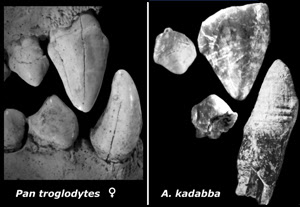Week 3 Biological Anthropology
Weekly Topics and subtopics
Primates
Human as Primates and Modern Human Adaptations
Paleoanthropology
Ardipithecus
Ardipithecus kadabba and Ardipithecus ramidus

Ardipithecus ramidus
Age: 4.4 Million
Place Ethiopia
Cranial Capacity 300-350cc
Notes Much of what we know about the Ardipithecus group comes from 1 skeleton, Ardi, found in 1994. Unlike all previously recognized hominins, Ardi had a grasping big toe adapted for locomotion in the trees and a pelvis that was definitely shaped like a biped, but not a fully human-like as the Australopithecus group. However, other features of its skeleton reflect adaptation to bipedalism. Like later hominins, Ardipithecus had reduced canine teeth. Ardipithecus ramidus had a small brain, measuring between 300 and 350 cm3. This is about the same size as a modern chimp brain, but smaller than the brain of Australopithecus like Lucy (~400-50 cm3), and roughly 20% the size of the modern Homo sapiens brain. Like chimpanzees, A. ramidus had a bit of a snout.
The teeth of Ardipithecus ramidus lacked the specialization of other apes, and suggest that it was a generalized omnivore and frugivore (fruit eater) with a diet that did not depend heavily on fibrous plants, ripe fruit or hard or abrasive food. The size of the upper canine tooth in Ardipithecus ramidus males was not distinctly different from that of females. Their upper canines were less sharp than those of modern common chimpanzees in part because of this decreased upper canine size, as larger upper canines can be honed through wear against teeth in the lower mouth. The features of the upper canine in A. ramidus contrast with the sexual dimorphism observed in common chimpanzees, where males have significantly larger and sharper upper canine teeth than females.
The less pronounced nature of the upper canine teeth in A. ramidus has been used to infer aspects of the social behavior of the species and more ancestral hominids. In particular, it has been used to suggest that the last common ancestor of hominids and African apes was characterized by relatively little aggression between males and between groups. This is markedly different from social patterns in common chimpanzees, among which intermale and intergroup aggression are typically high. Ardipithecus ramidus existed more recently than the most recent common ancestor of humans and chimpanzees (CLCA or Pan-Homo LCA), and thus is not fully representative of that common ancestor. Nevertheless, it is in some ways unlike chimpanzees, suggesting that the common ancestor differs from the modern chimpanzee. After the chimpanzee and human lineages diverged, both underwent substantial evolutionary change. Chimp feet are specialized for grasping trees; Ardipithecus ramidus feet are better suited for walking. The canine teeth of Ardipithecus ramidus are smaller, and equal in size between males and females, which suggests reduced male-to-male conflict.

Ardipithecus kadabba
Age: 5.2-5.5 Million
Place Ethiopia
Cranial Capacity ?
Notes Aligned with hominina by dentition. Chimps sharpen their canines by honing them on the premolar; Ardipithecus kadabba has lost its honing canine.
More information
